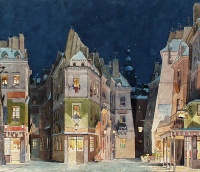Paris
From The Art and Popular Culture Encyclopedia
|
Related e |
|
Featured: |
Paris is the capital of France. It is a leading global cultural center and is renowned for its defining neo-classical architecture as well as its unrivaled influence in fashion and the arts. Nicknamed "the City of Light" or "Gay Paree" since the 19th century, Paris has a reputation as a "romantic city".
Walter Benjamin called Paris "the capital of the 19th century". Indeed, Paris was the birthplace of modern art and from the 1860s to the 1940s it was also the art capital of the world.
Nineteenth century Paris
Walter Benjamin called Paris "the capital of the 19th century". Indeed, Paris was the birthplace of modern art and from the 1860s ruled as cultural capital of the world until well into the 20th century.
The Industrial Revolution, the French Second Empire, and the Belle Époque brought 19th century Paris the greatest development in its history. From the 1840s, rail transport allowed an unprecedented flow of migrants into Paris attracted by employment in the new industries in the suburbs. The city underwent a massive renovation under Napoleon III and his assistant Haussmann, who leveled entire districts of narrow-winding medieval streets to create the network of wide avenues and neo-classical façades of modern Paris.
Cholera epidemics in 1832 and 1849 affected the population of Paris — the 1832 epidemic alone claimed 20,000 of the then population of 650,000. Paris also suffered greatly from the siege ending the Franco-Prussian War (1870-1871), and the ensuing civil war Commune of Paris (1871) killed thousands and sent many of Paris's administrative centres (and city archives) up in flames.
Paris recovered rapidly from these events to host the famous Universal Expositions of the late nineteenth century. The Eiffel Tower was built for the French Revolution centennial 1889 Universal Exposition, as a "temporary" display of architectural engineering prowess but remained the world's tallest building until 1930, and is the city's best-known landmark. The first line of the Paris Métro opened for the 1900 Universal Exposition and was an attraction in itself for visitors from the world over. Paris's World's Fair years also consolidated its position in the tourist industry and as an attractive setting for international technology and trade shows.
Further reading
See also
- Artistic Montparnasse
- Baron Haussmann
- Paris, May 1968 revolt
- Paris Commune
- Centre Pompidou
- Notre Dame cathedral
- La Vie Parisienne
- Un Regard Moderne, book shop





